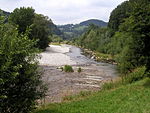GK Dürnrohr
2007 disestablishments in AustriaConverter stationsElectric power infrastructure in AustriaEnergy infrastructure completed in 1983

The GK Dürnrohr (German abbreviation for Gleichstromkurzkupplung Dürnrohr, in English meaning Dürnrohr HVDC-Back-to-Back Station) was a high-voltage direct current back-to-back scheme west of Dürnrohr substation, which was used for the energy exchange between Austria and Czechoslovakia between 1983 and 1996. The installation is no longer in use. The GK Dürnrohr had a nominal transmission rating of 550 MW. The nominal value of the DC voltage in the intermediate circuit was 145 kV. The transmission losses of the facility were 1.4%.
Excerpt from the Wikipedia article GK Dürnrohr (License: CC BY-SA 3.0, Authors, Images).GK Dürnrohr
Geographical coordinates (GPS) Address Nearby Places Show on map
Geographical coordinates (GPS)
| Latitude | Longitude |
|---|---|
| N 48.329555555556 ° | E 15.879861111111 ° |
Address
3435
Lower Austria, Austria
Open on Google Maps







